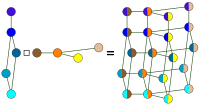| Name |
Condition for  |
Number of edges
 |
Example |
|
with 
abbreviated as  |
Cartesian product
(box product)
 |


 |


 |
 |
 |
Tensor product
(Kronecker product,
categorical product)
 |
 |
 |
 |
 |
Lexicographical product
 or or ![{\displaystyle G_{1}[G_{2}]}](//wikimedia.org/api/rest_v1/media/math/render/svg/2fb5fc505f29f9d3f03f199cea37a9141fab57ea) |


 |


 |
 |
 |
Strong product
(Normal product,
AND product)
 |




 |




 |
 |
|
Co-normal product
(disjunctive product, OR product)
 |


 |


 |
 |
|
| Modular product |


 |


 |
|
|
| Rooted product |
see article |
|
 |
 |
| Zig-zag product |
see article |
|
see article |
see article |
| Replacement product |
|
|
|
|
Homomorphic product[1][3]
 |


 |


 |
 |
|






 ...
...
















![{\displaystyle G_{1}[G_{2}]}](http://wikimedia.org/api/rest_v1/media/math/render/svg/2fb5fc505f29f9d3f03f199cea37a9141fab57ea)



























